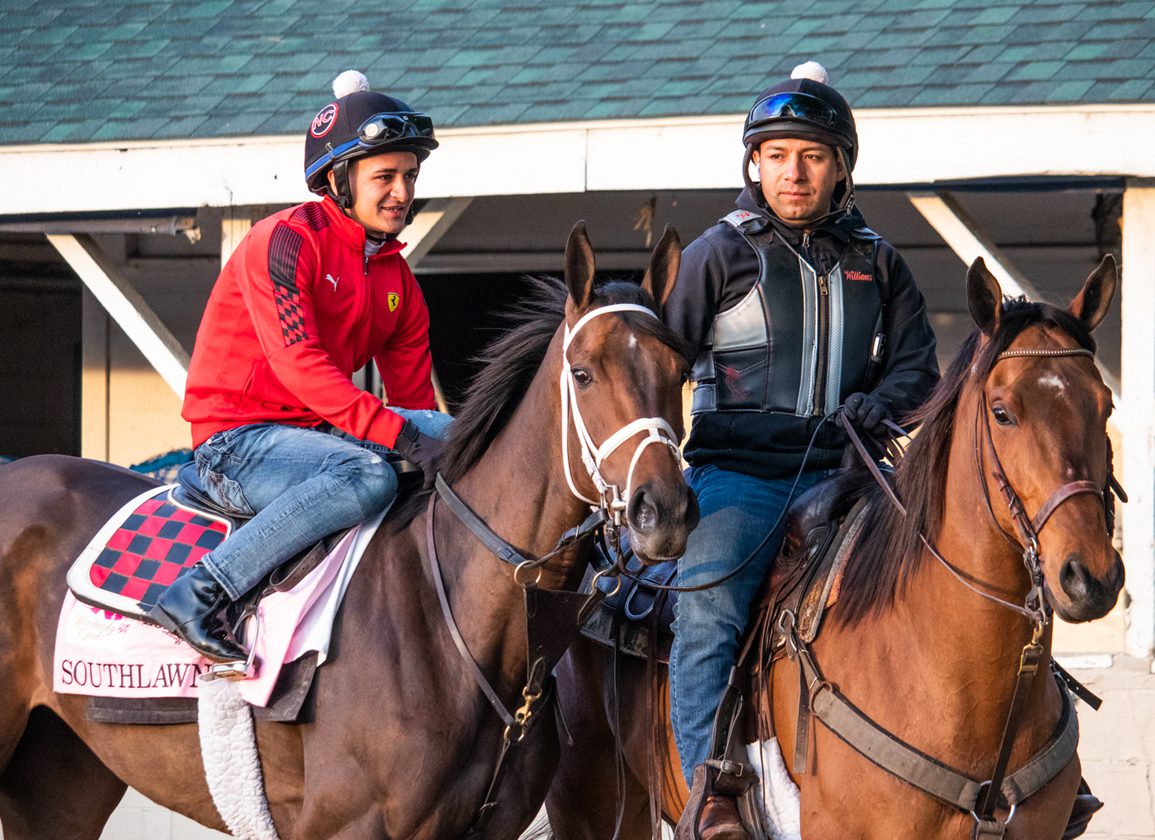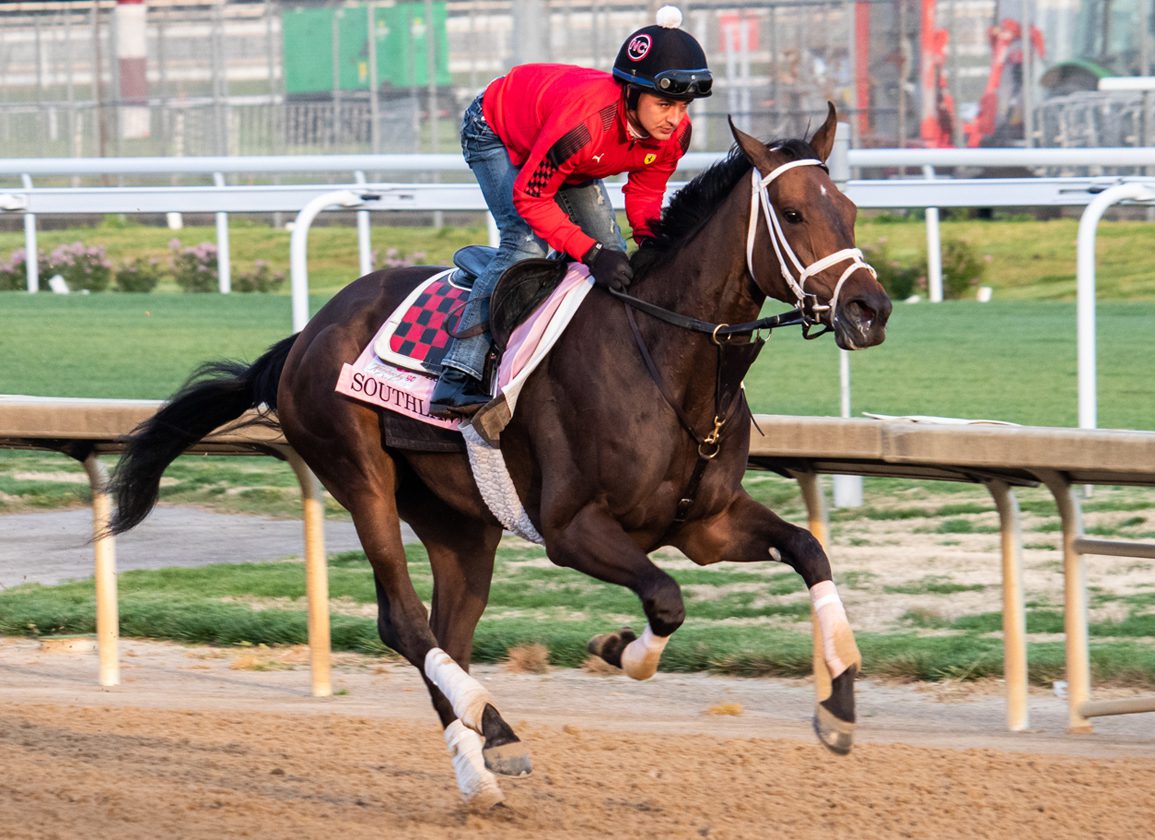Norm Casse lived in Louisville throughout most of his childhood, but one spring, he spent a few months in Ocala with his father. Norm was responsible for getting himself up and out the door for school each morning while his dad was busy at the training center.
One morning, as Kentucky Oaks day dawned, Norm's alarm never rang.
It was well into the morning before Mark Casse burst into his son's room in a panic. “Norman, why aren't you at school?” he cried.
“Dad, chill out,” retorted a teenaged Norm. “It's Kentucky Oaks day.”
That was the day that Norm Casse learned that the country's entire school system does not, in fact, shut down for Oaks day.
As a kid, the Kentucky Oaks marked a special occasion for Casse because it meant a Friday away from school in Louisville. Years later, after discovering his own passion for racing, working for his father for a decade, and now having trained on his own for six years, the Kentucky Oaks–and Derby week–has all come to mean so much more.
“I've been coming to the Oaks and Derby every year since 1995,” Casse reflected. “Even when I moved to Canada and worked for Dad up in Woodbine, the only weekend I ever took off was Derby weekend because I didn't want to break that streak. Being born and raised here is the reason why I do it. It's not because my family is involved. It's more because I love the Derby, the Oaks, and the whole week leading up to it.”
This year, Casse will saddle his first starter in one of those famed 3-year-old races with GI Kentucky Oaks contender Southlawn (Pioneerof the Nile). For Casse, who is a third-generation trainer and has already earned multiple graded stakes victories and just under 150 career wins, claiming his first Grade I on Friday would be a pinnacle moment.
“I can't really describe what it would mean to win the Kentucky Oaks,” he said. “All my friends and family are from here. They may not know what the Breeders' Cup Classic or the Pacific Class is, but they know what the Kentucky Oaks is. If we were able to win that, they'd look at me like a rock star.”
Casse comes to the Oaks with a filly that he and his team have always had high hopes for. Southlawn, a $290,000 yearling purchase for Robert Masterson, showed potential early on as a juvenile, but drawing out her true ability in the afternoons proved to be a puzzling task for Casse.
Southlawn was unplaced in her debut last June, finishing fifth behind none other than Mark Casse's future champion and Oaks contender Wonder Wheel (Into Mischief). After breaking her maiden by five lengths in her second start at Ellis Park, the filly from the final crop of Pioneerof the Nile was never a contender in the GIII Pocahontas S. and she came up empty in two tries on turf in the fall.
“After her last start on the grass here in the fall, we knew she was going to get the winter off,” Casse explained. “Tyler Gaffalione came back and said that she was having a lot of issues with her breathing. We sent her down to the Fair Grounds and we performed a myectomy on her. She's been undefeated ever since.”
The procedure seems to have solved any displacement issues the filly was dealing with as she has returned to the main track this year and has taken her first two sophomore starts by storm. She claimed an allowance at Fair Grounds by eight lengths in February and stamped her domination of the 3-year-old filly ranks in New Orleans with a win in the GII Fair Grounds Oaks.
Casse said that what has impressed him most about Southlawn's sophomore campaign is her developing running style.
“She doesn't have that early speed she had before,” he explained. “Now she makes a big, sustained run, which I think is going to be very beneficial in the Oaks. It just seems to me that she's better off breaking and trying to get a decent position, but then letting her get into her own rhythm and not forcing things too much. I like that she's so kind and professional now that no matter where we are in a race, we're still going to feel comfortable that she is going to run when Reylu asks her to run.”
Reylu Gutierrez, who competed in his first Kentucky Oaks last year, just claimed his first leading rider title at Fair Grounds earlier this year. The up-and-coming jockey has gained even more recognition while riding a hot streak at Keeneland.
“I think one of the storylines that shouldn't go unsaid is that Reylu gets along with her really well,” Casse noted. “He's riding really well right now and he's so confident in her and in how she's training that it gives me a lot of confidence.”
Another essential character in Southlawn's storyline is of course her owner Robert Masterson.
The California-based owner had horses in training with Mark Casse for many years, highlighted by the outstanding two-time champion grass mare Tepin (Bernstein). Tepin was in the Casse barn at the same time that Norm was overseeing much of the stable.
Casse said that working with the talented filly and playing a role in her success at the top of the game, from the 2015 GI Breeders' Cup Mile to the 2016 G1 Queen Anne S., gave him the confidence he needed to go out on his own. When Casse first set up his stable, Masterson was his first–and for a short time, his only–client.
Masterson has been involved in racing for over 40 years and explained why he wanted to support the fledgling trainer back in 2018.
“Norm was the one that really took care of Tepin the whole time she was there,” he said. “When he decided to go out on his own, I just felt an obligation. Everybody needs a shot and I felt like I could be the person to give him a shot. I'm not the guy who is going to have a 40-horse stable, and his father already had all these big owners, so I thought that I could give him four or five horses and that would help him out.”

Picked out by Deuce Greathouse, Southlawn was a $290,000 yearling purchase for Robert Masterson | Sara Gordon
While Casse's success quickly grew in those first few years, Masterson's horses ran through a streak of bad luck. But Masterson stuck with his trainer and was eventually rewarded for his faith with the success of Southlawn.
“We didn't have much luck in the beginning, but it wasn't because of Norm,” Masterson said. “I think he's a really good trainer and a good caretaker of the horse. You're going to look at him five years from now and people are going to go, 'Where'd he come from?'”
Other than horses he owns in partnership, Masterson sends all of his horses to Casse. His stable is off to a fast start in 2023 and Friday could set up to be a monumental day. On top of Southlawn's Oaks bid, Masterson's Grove (Munnings) and New Beat (Not This Time), both 3-year-old fillies coming off maiden wins, are aiming to get into the entries. He also has a juvenile filly named Loveland (Munnings) looking to make her debut.
Masterson, a graduate of the University of Maryland, said that Southlawn is named after a neighborhood in Maryland outside of Washington D.C. He explained that his mother moved to South Lawn to be close to him when he was in college and years later, his first son was born there.
While Masterson hinted at his excitement ahead of Oaks day, noting that this is his first starter in the historic contest, he added that he is hoping for a happy outcome because of the positive implications it would have for Casse, his longtime bloodstock agent Deuce Greathouse, and the filly's many other connections who are making a name for themselves in the industry.
“I've been in the business since 1980 and I've had a lot of great horses so I'm not nervous,” he said. “I just hope she gets all the right chances. We always thought she was really going to be good and when she came back as a 3-year-old, she was a monster.”
Southlawn will face her toughest competition yet on Friday. The rematch of Southlawn with GI Breeders' Cup Juvenile Fillies winner Wonder Wheel might be the start of a friendly father-son rivalry at the highest levels of the sport.
“When I went out on my own, my dad kept talking about how he couldn't wait until the day where we starting running against each other in these marquee races,” Casse explained. “So here's our first opportunity and it's a very cool opportunity. I'm just proud of my entire team. I feel like one of the things that we've done right since I went on my own is that I've built a really nice team that I'm confident in. I think they make a big, big difference in the stable and how well we're doing.”
Derby Week brings an unparalleled kind of excitement to the Churchill Downs backside, but Casse said he plans to embrace the hubbub and take in every moment. After all, it's an opportunity he's been dreaming about for years.
“I think the filly is training so incredibly well,” he said. “She looks great and her coat is great. She seems happier than ever and I know we're ready. I'm sure I'm going to be extremely nervous the morning of, but right now I'm just trying to enjoy the ride.”
The post Norm Casse Enjoying the Ride with First Oaks Filly appeared first on TDN | Thoroughbred Daily News | Horse Racing News, Results and Video | Thoroughbred Breeding and Auctions.

